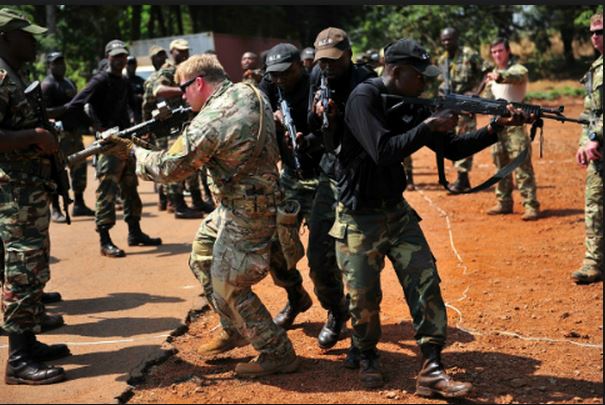On Friday, Sen. Lindsey Graham, of the Senate Armed Services Committee announced in a press briefing that the United States will be looking to increase U.S. Special Operations counter-terrorism missions within Africa.
This bit of welcome news comes on the heels of an operation that cost the lives of four members of the 3rd SFG that were ambushed while conducting a mission in Niger. If you haven’t been following Derek Gannon’s series on SOFREP.com, you’ve been missing out. He’s been on top of this story since the day it broke. Gannon appeared on CNN on Friday morning speaking about the Niger situation as well. SOFREP’s Jack Murphy was also slated to appear on CNN on Saturday morning. So to keep abreast of the situation with the best, most up-to-date information and analysis, stay tuned to SOFREP.com.
While most Americans weren’t aware of the on-going situation in Africa, our Special Operations troops certainly were. They’ve been conducting operations both in Niger and some of the surrounding countries for quite some time. As Gannon pointed out, now the Special Operations troops will have a direct intelligence pipeline to Washington. That element has been sadly missing for quite some time.
Congress, specifically the Armed Services Committee has been admittedly “out of the loop” according to Graham in regards to Niger and Africa as a whole. Graham vowed that this situation is going to change. And in surprisingly strong language, he made it clear that terrorism, especially Islamic terrorism is going to be strongly addressed in Africa. “The American people need to be ready to more, not less [U.S. military] actions throughout Africa,” Graham said. This will relax the rules of engagement for our Special Operations troops on the ground and allow them to take a more offensive role in targeting the constantly changing terror groups.
But just as importantly, this will open up the area for more and better intelligence operations.The U.S. should also push the Niger government politically for a more liberal use of the US’ drone power and allow the drones to be armed in the future. The US has placed drone bases already in Niger and those will now become even more valuable to the overall effort as the US will ramp up activities in Niger and beyond.
The US Special Operations Command will increase the Direct Action (DA) and Counter-Terror (CT) missions but the Special Operations Forces will also increase their footprint by sending increasing units (Special Forces, Green Berets) to assist in Foreign Internal Defense (FID) as well as Security Force Assistance in Niger and other surrounding countries that are now in the “gray zone” between war and peace.
In the intelligence realm, the US will be forced to rely on trained Nigerien proxies in the HUMINT (Human Intelligence) field as American intelligence operatives will not blend in with those type of situations in the field. However, as we talked about back in July, the full range of intelligence activities to include targeting by the Counter-Terrorism Center of the CIA which target specific terrorist groups and leaders will now be given a larger share of their collection activities.
There will be more intelligence requirements to support the overall US objectives in the area. These will include but not be limited to:
• Military and paramilitary organizations.
- Economics.
- Politics.
- Climate.
- Geography.
- Sociology.
- Ethnic composition.
- Religious factors.
- Personalities.
Much of this information is already generated by Special Forces A-Teams during their pre-deployment area study guides but national intelligence agencies will also keep much of the information up to date.
The most immediate need for Special Operations Forces in the theater will be force protection in the areas where they’ll be based from. Force protection is an extremely important factor in the overall security for the mission. Here, local intelligence nets must be organized and resourced. They can be tailored to fit the mission and the operational area. This expertise has been used since the times of the teams of the Office of Strategic Services (OSS) in World War II. The OSS was the forerunner of both the CIA and the US Army Special Forces.
Special Forces have exceptionally trained personnel and are very well versed in spotting, assessing, developing, and recruiting low-level sources for force protection requirements. These operations are extremely important in the force protection and early warning in the operational areas.
Close coordination with the CIA and other national and theater intelligence agencies may be required to identify potential in-country sources. It is important because the area doesn’t need “cross-pollination” or the duplication of effort and/or assets.
With the expanded role in Africa, Special Operations Forces will once be lead element in the US footprint of the mission there. SOF will build our host nation partner’s capacity, collect intelligence, hunt high-value targets, and conduct other counterterrorism operations in multiple countries across the continent. One can expect to see JSOC (Joint Special Operations Command) much more actively involved once the key players become more involved. JSOC was created in 1980 as a counter-terrorism force but their operations have been expanded to include psychological operations, (military information operations is another name for it that has been frequently used) and sometimes to trace the financial dealings of terrorist organizations thru banking systems.
The US has the capabilities to annihilate the terrorists on the continent of Africa on the field of battle, that isn’t even a question. But now with a renewed sense of emphasis there, the need will also include what LTG Charlie Cleveland called the “exquisite capabilities to manipulate them.” Killing the terrorists is not enough anymore. The U.S. must find ways to generate desired psychological effects, such as shifting a population’s loyalty to a host nation allied government, as well. This requires specific intelligence and a firm grasp of the local situation. Something our policy overall has lacked…for quite some time.
Photo: US Air Force
